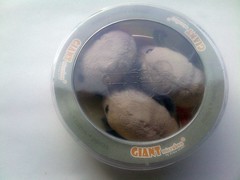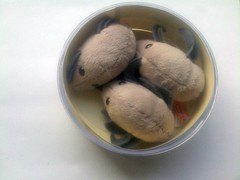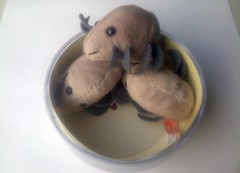Dust mites were also first discovered by the inventor of the microscope, Antonie van Leeuwenhoek. In 1694, he reported microscopic "little animals" that live in dust.
Up to 40% of the world's population has been diagnosed with an allergic disease. The most prevalent allergy is to house dust mites (http://buff.ly/1jSF5Y6).
GIANTmicrobes is a toy company based in Stamford, CT. GIANTmicrobes manufactures plush toys resembling microbes, including a number of clinically important human pathogens. The toys were developed primarily for educational, if not in some cases ironic, value.


3 Dust Mites in a Petri Dish by GIANTmicrobes/Amazon. These are cuter in person and one patient named them "Dusty, Rusty and Trusty." The toys are not exactly anatomically correct, of course. For example, dust mites do not have eyes or antennae. They have 8 legs and a mouth-like appendage. I use the plush toys below in most of my lectures and clinic visits related to indoor allergens, asthma, and allergic rhinitis. They make an unforgettable impressions and drive home the message that the dust mite is "real" and it is the most important indoor allergen.


The appearance of each 5-7 inch long toy is based on electron micrographs of the real microbe, thus the toys represent an approximate million-fold magnification of the actual organisms. In order to appeal to the general public and present an air of lovability, many of the toys are brightly colored and furry. To further anthropomorphize them, they typically feature two eyes and in some cases other facial features.
No comments:
Post a Comment